|
|
|
Reviews and Observations on
Silent Westerns
by Boyd Magers |
As the forerunner of the sound westerns we all enjoy, the silent westerns that still exist deserve our consideration and attention. As seemed to be the custom of the day, you’ll notice in silents many of the cowboy heroes mix light comedy with hard action. This style was carried over into talkies primarily by Hoot Gibson, but to a lesser degree by Ken Maynard and Buck Jones, eventually giving way to straight action from the star of the film with the comedy elements left to the sidekicks (Gabby, Fuzzy, Smiley, etc.) Silent westerns also exhibited stronger roles for women and usually more romance than in the sound era B-westerns.
For specific stars or titles, use your "Find on this page" feature on your computer.
The
Ratings |
|
|
Average
 
|
Very little of Interest

|
Not Worth
your time!

|
Posted 12/24/18
   COWBOY AND THE FLAPPER (1924 Goldstone/ Truart) 51 minutes COWBOY AND THE FLAPPER (1924 Goldstone/ Truart) 51 minutes
Directed by prolific Alvin Neitz, Marshal William Fairbanks poses as outlaw Handsome Ed Burns to infiltrate Jack Richardson’s bank robber gang. Eastern girl Dorothy Revier, separated from her horse and bewildered in the west, is captured by the gang. Fairbanks tries to help her escape, but she believes him one of the outlaws. The “flapper” title is a misnomer, Dorothy is just an eastern girl come to visit her Dad out west—perhaps an attempt to “modernize” the Western for female moviegoers. Born Doris Velegra in San Francisco in 1904, the 5'4" 115 lb. actress entered films at 17 in 1921 acquiring her screen name from her then husband, director Harry Revier. She co-starred in about nine films with Fairbanks. After making “The Cowboy and the Kid” in ‘36 with Buck Jones, Dorothy turned to writing and painting. Divorced from Revier in 1926, she later married a commercial artist. She died in 1993. 5' 11" William Fairbanks was born Carl Ullman in 1894 in St. Louis, MO. After some stage work he came to movies in 1917 but didn't begin to star in Westerns until 1921, first for producer Phil Goldstone as well as for Ben Wilson at Arrow. After co-starring in “The Vanishing West” with Jack Perrin in 1928, Fairbanks saw the coming of sound and left the business. His later life is unknown except that he died of pneumonia on April 1, 1945 in L.A.
Posted 7/4/18
   UNSEEN ENEMIES (1925 Anchor) 38 minutes UNSEEN ENEMIES (1925 Anchor) 38 minutes
In 1920, nineteen year old Al Stone, half-brother of cowboy star Jack Hoxie, joined Jack in Hollywood. Changing his last name to Hoxie, Al found roles in his brother’s Westerns, among others, and finally signed with producer Morris R. Schlank in 1926 for a series of seven low budget Westerns, the first of which is “Unseen Enemies”. Riding into Bordertown, Al as “Happened Along” Meredith always seems to run into trouble. He finds crooked Bob Kortman exerting a mysterious influence over pretty Catherine Craig’s ranch as he and owlhoots smuggle dope across the border. Hard action is minimal and there’s perhaps a bit too much comedic fill-time here and there with sidekick Max Ascher. Directed by J. P. McGowan.
Posted 12/19/17
     THE STRUGGLE (1913 Broncho Film Corp) 22 minutes THE STRUGGLE (1913 Broncho Film Corp) 22 minutes
Young Bob Worth (Elmer Morrow), after seeing his father murdered by a stranger, vows revenge. Years later the stranger is slain in a barroom shootout and Bob, although innocent, is arrested for the murder. On his way to hang, while battling marauding Indians with his Army captor, the real killer gives a dying confession which exonerates Bob. A good plot and constant action holds your interest. Although purported by Oldies.com to be a Bronco Billy short, the star here is 26 year old Elmer Morrow (1887-1975) in his first film of eight between 1913-1915. The confusion may come because there were several silent shorts titled “The Struggle” and oddly Bronco Billy Anderson played a doctor in one also released in 1913. Broncho Film Corp. was forned in 1913 by Adam Kessel and Charles Bauman after they left Universal. They specialized in Westerns as did their earlier company, Bison (1909-1912), which merged with Universal.
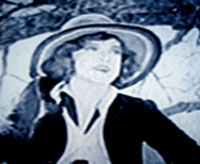   THE STAMPEDE (1921 Kremer) 45 minutes THE STAMPEDE (1921 Kremer) 45 minutes
“Tex” Henderson (Texas Guinan) can ride a horse and throw a lasso as good as any man, but she can’t rope the heart of Francis Ford, an easterner come west lured by the promise of free land in an upcoming ‘Stampede’ or land rush. He sees her as a “funny” tomboy. Even Tex wearing eastern clothes at a big pre-stampede dance doesn’t seem to woo Ford. Enter villanious Fred Kohler who learns their is gold on the land Ford has his eye on and he plots to steal the land rush from Ford by hook and crook. But he doesn't reckon on the determination of Tex to do all she can to aid Ford. Starts off as a bit of a romantic Western comedy, but builds into a rousing finale. Written by Eugenie Kremer, wife of Victor Kremer who owned Kremer Films.
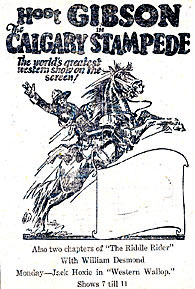    THE CALGARY STAMPEDE (1925 Universal) 69 minutes THE CALGARY STAMPEDE (1925 Universal) 69 minutes
In Canada, Champion American rodeo rider Hoot Gibson meets, falls in love with, and wants to marry Virginia Brown Faire but her deputy game warden father (Pierre Faunce) absolutely forbids it, feeling Hoot is a “no-good Irish cowpuncher.” When her father is murdered by reservation proacher Jim Corey, whom Faunce sent to jail years ago, Virginia believes Hoot guilty. Virginia’s maid, Nennah (Ynez Seabury), saw Corey kill Faunce but holds her tongue because she is Corey’s girl. Barely escaping the Mounties, Hoot leaves the region. A year passes. Drifting, disguised as a boob, Hoot peels potatoes on Charles Sellon’s Bar O Ranch. Suspicioned by Mountie Philo McCullough, Hoot is afraid to demonstrate his riding skills to help Sellon win at the Calgary Stampede rodeo in order to save his ranch. But—when Sellon’s top rider breaks a leg, Hoot must step in, even though he knows he will be arrested. Fortunately for him, Corey turns up at the Stampede. Nennah is overjoyed to see her old flame, but is publicly rejected by the cad. Shunned, she explains to Virginia and the Mounties that Corey is the real killer and Hoot reunites with his love. Typical plot, but well done, even though actual Calgary Stampede footage is under used.
Posted 3/18/17
    ANOTHER MAN’S BOOTS (1922 Aywon) 60 minutes ANOTHER MAN’S BOOTS (1922 Aywon) 60 minutes
Cattleman Harry Smith is summoned home by his sister Elvira Weil and her blind father to save the mining claim of his estranged family but he is gunned down by rustlers before he can make it home. Smith implores his trusted friend Francis Ford (John Ford’s elder brother) to assume his identity and go home to help his sister and father whom Smith has not seen in 15 years. Believing Smith dead, Ford accepts but finds saving the family won’t be all that easy as greedy saloon owner Bob Kortman is after the property himself as the family only has six weeks to finish the assessment on the mining claim. Matters turn even worse when Kortman learns Ford is not who he claims to be! Kortman frames Ford for killing the man he is impersonating.   Daniel F. Whitcomb’s script idea was appropriated several times in the sound era: “Gun Law” (‘33) w/Jack Hoxie; “Cyclone Ranger” (‘35) w/Bill Cody, “Melody of the Plains” (‘37) w/Fred Scott; “Bullet Code” (‘40) w/George O’Brien and “Gauchos of El Dorado” (‘41) w/The Three Mesquiteers. Daniel F. Whitcomb’s script idea was appropriated several times in the sound era: “Gun Law” (‘33) w/Jack Hoxie; “Cyclone Ranger” (‘35) w/Bill Cody, “Melody of the Plains” (‘37) w/Fred Scott; “Bullet Code” (‘40) w/George O’Brien and “Gauchos of El Dorado” (‘41) w/The Three Mesquiteers.
 Ford, born Frank Thomas Feeney, August 14, 1881, in Portland, ME, dropped out of high school and joined the Army during the Spanish-American War. He came to movies in 1909 and from 1910-1920 he starred in dozens of Western two-reelers, many co-featuring Edith Storey, Grace Cunard and Anna Little. In the ‘20s Ford began supporting Hoot Gibson, Franklyn Farnum, Buck Jones, Tom Mix, Yakima Canutt, Jack Hoxie and Ken Maynard. As well in the silent era he directed some 177 shorts between 1912-1928. As sound came in Francis continued to essay parts large and small until his death at 72 on September 5, 1953. Ford, born Frank Thomas Feeney, August 14, 1881, in Portland, ME, dropped out of high school and joined the Army during the Spanish-American War. He came to movies in 1909 and from 1910-1920 he starred in dozens of Western two-reelers, many co-featuring Edith Storey, Grace Cunard and Anna Little. In the ‘20s Ford began supporting Hoot Gibson, Franklyn Farnum, Buck Jones, Tom Mix, Yakima Canutt, Jack Hoxie and Ken Maynard. As well in the silent era he directed some 177 shorts between 1912-1928. As sound came in Francis continued to essay parts large and small until his death at 72 on September 5, 1953.
Francis’ fame in Hollywood as an actor and director was what motivated little brother John Ford to do the same, largely as an act of competition. In the history of film, certainly John Ford will be better remembered but Francis’ total body of work as an actor in at least 494 films, a director of 177, writer of 28 and producer of about 11 must not be forgotten.
Director Jack Conway (1887-1952) began as an actor/director in 1912. He helmed many silent Westerns with J. Warren Kerrigan, Roy Stewart, Hoot Gibson, Tom Mix and George O’Brien along with dramas and action films. He progressed into silents with many top flight A’s—“Red Headed Woman” (‘32), “Viva Villa” (‘34), “Tarzan and His Mate” (‘34), “A Tale of Two Cities” (‘35), “Saratoga” (‘37) and “Boom Town” (‘40) among many others.
Posted 6/30/16
    A DESPERATE CHANCE (1926 Rayart) 47 minutes A DESPERATE CHANCE (1926 Rayart) 47 minutes
“Bulldog” Prentice (Lew O'Connor), a greedy land developer, wants to control water rights in his county. He also fires his bookkeeper, Barney Furey, for keeping time with his daughter. Furey vows revenge. To aid in his power for land control, Bulldog has his henchmen, Slim Whitaker and Leon de la Mothe, erect a tollgate at a pass that will prevent kindly land owner Lafe McKee and his daughter Ione Reed access to their ranch so they will sell out to Bulldog. At this point Bob Reeves returns to the town from which he was railroaded out of 10 years ago. Infuriated at Bulldog's crooked ways he joins Lafe McKee and his daughter to stop the greedy developer. Then—suddenly Bulldog is mysteriously shot in the back and killed. McKee is blamed and arrested by Sheriff Frank Ellis. Whitaker and de la Mothe plan to take over Bulldog's plans but they are thwarted by Reeves who also uncovers the real murderer of Bulldog. Directed by J. P. McGowan, the plot builds slowly and winds up in a whirlwind of action.
Posted 1/9/16
   PHANTOM OF THE FOREST (1926 Gotham/Lumas Film Corp) 59 minutes Searching for oil deposits Eddie Phillips is working for his father (Rhody Hathaway) in the northwoods. A pup intended for Eddie becomes a stray in the forest but through his instinct and cunning he learns to exist on his own (played by Thunder, the Marvel Dog). A year later, Phillips and another dog, White Fawn, are camping in the woods where, unbeknownst to them, snarky Jim Mason secretly locates oil on Betty Francisco’s land. Mason is seen and is instinctively hated by Thunder who tangles with the poacher. When the fight is observed by Phillips and Francisco, Thunder is befriended by the couple but during the encounter White Fawn “elopes” with Thunder. Mason and cohort Frank Davis attempt to get Betty to sign over oil options on her property but are thwarted by Thunder. Failing their initial plot, the unscrupulous pair buy up Betty’s mortgage and demand the $120 interest payment which she doesn’t have. But when Phillips pays the interest for her, Mason, once again stymied in his plans, seeks revenge by setting fire to the forest, but Thunder intervenes. PHANTOM OF THE FOREST (1926 Gotham/Lumas Film Corp) 59 minutes Searching for oil deposits Eddie Phillips is working for his father (Rhody Hathaway) in the northwoods. A pup intended for Eddie becomes a stray in the forest but through his instinct and cunning he learns to exist on his own (played by Thunder, the Marvel Dog). A year later, Phillips and another dog, White Fawn, are camping in the woods where, unbeknownst to them, snarky Jim Mason secretly locates oil on Betty Francisco’s land. Mason is seen and is instinctively hated by Thunder who tangles with the poacher. When the fight is observed by Phillips and Francisco, Thunder is befriended by the couple but during the encounter White Fawn “elopes” with Thunder. Mason and cohort Frank Davis attempt to get Betty to sign over oil options on her property but are thwarted by Thunder. Failing their initial plot, the unscrupulous pair buy up Betty’s mortgage and demand the $120 interest payment which she doesn’t have. But when Phillips pays the interest for her, Mason, once again stymied in his plans, seeks revenge by setting fire to the forest, but Thunder intervenes.
  BAD MEN’S MONEY (1929 Bell/Davis Dist.) 39 minutes Disreputable Lew Meehan has been appointed by the court to handle business affairs for Peggy Montgomery’s failing ranch. Meehan is stymied in his plans to grab off the ranch by Yakima Canutt and his partner, banker John Lowell, who purchase the property at public auction. Meehan’s henchies Bud Osborne and Frank Ellis try their best to do away with Yak in this late-in-the-day, often splicy silent. There is a good set-to between Yak and Osborne at the wind-up. Most interesting aspect of this otherwise drab affair is Charles “Slim” Whittaker as bespeckled, grinning correspondence school graduate Percifival. Almost always cast as a heavy, here Whittaker obligingly displays his comic talents—talents he also was able to later put to use in Jack Luden’s “Pioneer Trail” (‘38) and George O’Brien’s “Bullet Code” and “Prairie Law” (both ‘40). BAD MEN’S MONEY (1929 Bell/Davis Dist.) 39 minutes Disreputable Lew Meehan has been appointed by the court to handle business affairs for Peggy Montgomery’s failing ranch. Meehan is stymied in his plans to grab off the ranch by Yakima Canutt and his partner, banker John Lowell, who purchase the property at public auction. Meehan’s henchies Bud Osborne and Frank Ellis try their best to do away with Yak in this late-in-the-day, often splicy silent. There is a good set-to between Yak and Osborne at the wind-up. Most interesting aspect of this otherwise drab affair is Charles “Slim” Whittaker as bespeckled, grinning correspondence school graduate Percifival. Almost always cast as a heavy, here Whittaker obligingly displays his comic talents—talents he also was able to later put to use in Jack Luden’s “Pioneer Trail” (‘38) and George O’Brien’s “Bullet Code” and “Prairie Law” (both ‘40).
Posted 5/27/15
    ARIZONA EXPRESS (1924 Fox) 82 minutes ARIZONA EXPRESS (1924 Fox) 82 minutes
Not a bona-fide Western, but worthy of note due to the last half of the film which is truly as exciting as it gets, front-loaded serial-like with daredevil fights, dangerous stunts, gun battles aboard the runaway Arizona Express train as it careens wildly through the mountains…then there’s a horse chase finale. Bank employee Harold Goodwin is accused and railroaded into prison for the murder of his uncle (William Humphrey) but the real killers are gangster Francis MacDonald and his dance-hall gal pal Evelyn Brent who were plotting to rob the bank. Sentenced to hang, Goodwin escapes jail during a prison riot. Hiding out, his sister, Pauline Starke, vows to help prove his innocence by infiltrating MacDonald’s gang. Gaining the evidence to free her brother she must get the proof to the Govenor. Pursued by MacDonald’s gang, Pauline enlists the aid of railroader David Butler on the Arizona Express in a desperate race for life.
  GOLDEN TRAIL (1925 William Mix Prod.) 58 minutes GOLDEN TRAIL (1925 William Mix Prod.) 58 minutes
Owing mortgage money on his mine to skinflint Frank Austin, Dick Hatton (left) rides off on his own horse which Austin has demanded in payment for the mortgage. Hunted by the law, Hatton is there when his mining partner (Harry Belmour) is killed in a mining explosion. As he dies Belmour asks Dick to care for his daughter who is arriving from the East. Also arriving from the East is Austin’s daughter (Dorothy Wood). Dick makes the mistake of believing Dorothy is the daughter of his dead partner and, although outlawed, actually rescues Dorothy from the clutches of outlaw Lew Meehan who is holding her for ransom. There's a large reward for Meehan enabling Dick to pay off his mortgage and, of course, fall in love with Dorothy. Filmed around Kernville, this one’s strong on plot, but light on action till the end.
Posted 3/5/15
  SNOWSHOE TRAIL (1922 FBO) 53 minutes SNOWSHOE TRAIL (1922 FBO) 53 minutes
Herbert Prior makes a deathbed confession to lawyer Spotiswoode Aitken that years ago he murdered his gold mine partner, the father of Roy Stewart. Prior gives Aitken a map and asks him to find Stewart and deed the mine to him. But the crooked lawyer keeps the map for himself and sends Prior’s useless son Lloyd Whitlock into the frozen North Country looking for Stewart. A year later, on a pretense of looking for Whitlock—but really searching for the mine—the plotting lawyer and Jane Novak, once engaged to Whitlock go looking for the missing Whitlock. Unknowingly, they hire Stewart as their northwoods guide. While crossing a raging river, Jane is nearly drowned but is saved by Stewart. Swept far downstream, Stewart takes Jane to his remote cabin. Meanwhile, lawyer Aitken is killed in a mountain accident. Stranded for weeks, Stewart and Novak grow “close”. Out hunting one day, Stewart discovers the missing Whitlock and some halfbreed cohorts in a cabin. Reluctantly, he rejoins Novak with her onetime fiancé. On an expedition the threesome stumble across the lost mine. After several treacherous acts by Whitlock and his halfbreeds, Jane realizes it is Stewart she truly loves.
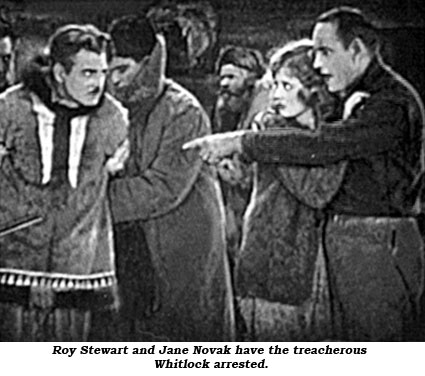
   BLACK GOLD (1924 Steiner) 38 minutes BLACK GOLD (1924 Steiner) 38 minutes
After being cheated in a card game, Pete Morrison and black train conductor Sam are thrown off the train. They soon meet Peggy Montgomery and her gramps, Joseph Morante, who, unbeknownst to Morrison, are being pressured by Jack Walters, a crooked agent of Morrison’s father, Arthur Thalasso, to sell their oil rich property to Thalasso’s syndicate. When Morrison’s father eventually shows up at the ranch in person, Morrison sides with Peggy and her gramps. Walters attempts to ambush Morrison, but Morrison whups the tar out of the devious agent making Thalasso come to his sense. He makes his son his new field manager and cuts a square deal with Peggy and Gramps.
 ROARING RIDER (11 minute edit of THUNDERING ROMANCE, 1924 Artclass) ROARING RIDER (11 minute edit of THUNDERING ROMANCE, 1924 Artclass)
Buffalo Bill Jr. arrives to help pretty Jean Arthur when crooks plan to foreclose when Jean can’t meet her bank note. Jean and Bill plan a cattle drive to sell the herd in order to raise cash to pay the note but rustlers stampede the herd. Naturally, much is left out when there’s only 11 minutes left of a film, but at least it gives us the flavor of an otherwise lost silent.
Posted 1/13/15
  WILD HORSE CANYON (1926 Goodwill) 49 minutes WILD HORSE CANYON (1926 Goodwill) 49 minutes
Edward Cecil, the foreman for ranch owner Helene Rosson, captures a wild horse herd but the leader of the herd (played by Yakima Canutt’s real life horse, Boy) breaks them loose. Cecil blames drifter Yak for turning them loose, turning Rosson against the cowboy. Meanwhile, at every opportunity, Yak keeps taunting and tormenting Cecil by leaving quirts on his saddle and everywhere Cecil is. Seems when Yak was a boy 15 years ago Cecil killed Yak’s father with a quirt. Now Yak is out for justice. Kinda choppy and slow til the stunt-filled finish.

Posted 12/17/14
   SILVER SPURS (1922 Doubleday/Western Pictures) 50 min. SILVER SPURS (1922 Doubleday/Western Pictures) 50 min.
New York author Lester Cuneo, bored with his Manhattan life, is given a pair of silver spurs for luck by his fellow club members before he leaves to find adventure and romance in California. Once in California he befriends Lillian Ward, a beautiful Spanish heiress who has lost her rancho to the trickery of greedy and violent Bert Sprotte. Following a series of clashes with Sprotte and his henchies, Cuneo recovers the original Spanish land grants and saves Ward’s rancho, marrying her in the process. Also in the cast—Lafe McKee as a prospector who helps Cuneo, Zala Zarana, a café dancer and lover of Sprotte who causes friction between everyone, including Sprotte’s abused wife Dorris Willott. Nicely photographed by Floyd Jackman; scripted and directed by Henry McCarty and (James) Leo Meehan (not Lew Meehan as often reported).

Posted 3/6/14
  VENGEANCE OF HATE (circa 1924 Capital) (Re-issue of THE END OF THE CIRCLE 1913 Essanay) 34 minutes VENGEANCE OF HATE (circa 1924 Capital) (Re-issue of THE END OF THE CIRCLE 1913 Essanay) 34 minutes
Far from an action picture, this is a soap-operaish Western drama in which the impending marriage between Fred Church and Eleanor Blevins is broken off when jealous rivals True Boardman
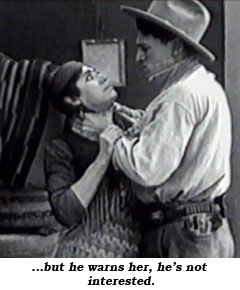 and Evelyn Selbie conspire to make it appear Church is unfaithful. Hurt and on the rebound Blevins marries Boardman. Selbie comes-on to Church but he rejects her. Five years pass…a child (Lois Ingraham—real life daughter of director/actor Lloyd Ingraham) is born to Blevins and Boardman, but he has become a worthless, drunken gambler. When he dies from a mountaintop fall and Blevins dies from illness, Church—who just happens to be prospecting nearby—saves the child from a wandering bear and, with both her parents dead, takes the young girl to raise as his own. and Evelyn Selbie conspire to make it appear Church is unfaithful. Hurt and on the rebound Blevins marries Boardman. Selbie comes-on to Church but he rejects her. Five years pass…a child (Lois Ingraham—real life daughter of director/actor Lloyd Ingraham) is born to Blevins and Boardman, but he has become a worthless, drunken gambler. When he dies from a mountaintop fall and Blevins dies from illness, Church—who just happens to be prospecting nearby—saves the child from a wandering bear and, with both her parents dead, takes the young girl to raise as his own.
   THE RATTLER (1925 Ermine Productions) 42 minutes THE RATTLER (1925 Ermine Productions) 42 minutes
Jack Mower may be one of the lesser known silent cowboy range riders, but his work output as a star, serial hero, character player and extra covered 46 years from 1914 to 1960 and nearly 600 films. Born in Hawaii or California, sources differ, on September 5, 1890, he attended college in Hawaii, worked on the stage in musical comedies, then signed up with Vitagraph in 1914, appearing in a number of shorts with William Duncan and starring in a few himself. In 1917-‘18 he was with the independent Henry Pollard Company playing the male lead to Margarita Fischer in romantic comedies. In 1919 the 6' 1" Mower starred with Helen Holmes in “The Tiger Band” serial released by Warner Bros. In the early ‘20s he worked in other serials, supported Buck Jones, Roy Stewart and others and starred for Universal in their “In the Days of Daniel Boone” serial in ‘23. Based on response to the serial, Universal signed Jack for a series of two-reeler Westerns in ‘23-‘24. In ‘24 Mower starred in Pathé’s 10 chapter serial “Ten Scars Make a Man”. For whatever reason Jack Mower became Jack Meehan for five feature Westerns released by Ermine Productions in 1925. It was back to Mower in ‘26 for a series of Western shorts for Universal from fledgling director William Wyler. No more starring roles followed for Mower but he certainly became a proficient supporting player (especially at Warner Bros. in the ‘30s and ‘40s) through 1960. He died at 74 on January 6, 1965, in Hollywood.   In “The Rattler” Mower (Meehan) is in love with ranch owner George Williams’ daughter Alma Rayford. But so is sleazy William Buckley. When Mower and Rayford plan to elope the duplicitous Buckley lures them to a hidden cabin where he and accomplice Vester Pegg hogtie Mower while Buckley attempts to trick Rayford into marrying him. (There are no title/credits on the viewed print.) In “The Rattler” Mower (Meehan) is in love with ranch owner George Williams’ daughter Alma Rayford. But so is sleazy William Buckley. When Mower and Rayford plan to elope the duplicitous Buckley lures them to a hidden cabin where he and accomplice Vester Pegg hogtie Mower while Buckley attempts to trick Rayford into marrying him. (There are no title/credits on the viewed print.)
Posted 1/20/14
    THE WHITE OUTLAW (1925 Universal) 55 minutes THE WHITE OUTLAW (1925 Universal) 55 minutes
Cruelty to Jack Hoxie’s horse Scout by a ranch hand drives Scout away, becoming an outlaw stallion with an ever growing herd. Jack is forced to bring Scout in when Scout is suspected of “rustling” rancher’s horse herds. Duke Lee and other ranchers vote to put Scout to death. Jack agrees, but… Interestingly, in a prologue to the story, Hoxie steps out and introduces Scout and his dog Bunk. One later scene shows Jack putting Scout through all his tricks. Filmed in the Alabama Hills of Lone Pine, CA. Reportedly, Hoxie’s favorite film.
Posted 7/8/13
   RIDERS OF THE PASS (1925 Universal) 18m RIDERS OF THE PASS (1925 Universal) 18m
When Fred Humes tries to help a rancher and his daughter rout the rustlers plaguing them he is first mistaken for a Prince visiting the U.S. then is taken for a rustler himself. Constant movement, a good fight between the rustler boss and Fred and terrific Lone Pine locations elevate this two-reeler.

 OH, JOHNNY (1918 Goldwyn) 41m OH, JOHNNY (1918 Goldwyn) 41m
Samuel Goldwyn tried to mold Louis Bennison into a star of action films, not unlike the image of Douglas Fairbanks, but it doesn’t work. Bennison comes off very non-heroic looking more like a drugstore cowboy. Here, Bennison, half owner of the Lost Camp Mine in the mother lode of Panamint Conty, prevents his dead partner’s daughter (Virginia Lee) from being swindled out of her share in the mine, first by saloon heavies Boris Karloff (in one of his first screen appearances), Charlie Romero and Edward Roseman, and then by scheming relatives back East. (The surviving print has severe water damage at the outset and is cut short at only 41 minutes.)

Posted 3/3/13
  THE STOLEN RANCH (1926 Universal) 56 minutes THE STOLEN RANCH (1926 Universal) 56 minutes
Returning from WWI, Fred Humes protects his shell-shocked friend, Ralph McCullough, who was mentally scarred by battle. True pals, they return west to find McCullough’s ranch taken over by foreman William Norton Bailey, now claiming the ranch as his own. Humes obtains a job on the ranch and falls for Louise Lorraine (in real life Art Acord’s wife). Meanwhile, McCullough stays hidden and in doing so meets and falls in love with Nita Cavalier who has come west aspiring to be an artist. Bailey, henchman Slim Whitaker, and crooked lawyer Edward Cecil plot to defraud McCullough of his ranch, but Humes overhears the plot, retrieves the original deed and saves his friend’s life. Watch for a young Jack Kirk as a ranch hand in his first film. Filmed at Lone Pine, CA, and nicely handled by 24 year old William Wyler who cut his directorial teeth on silent westerns and went on to win three best director Academy Awards. After several years working as a bit player, stand-in, etc. in talkies, Humes left movies and became a miner. He died of dementia at 74 in 1971.

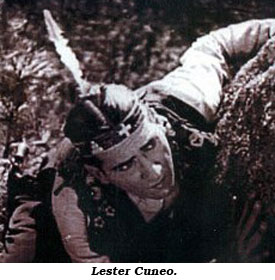   BLAZING ARROWS (1922 Western Pictures) 55 minutes BLAZING ARROWS (1922 Western Pictures) 55 minutes
A white child is saved by a Sioux Indian couple and raised to manhood as Sky Fire (Lester Cuneo). Completely unaware he is not Indian, he attends college posing as a white man and falls in love with Francelia Billington (his real life wife). However, when he seeks permission to marry her from her guardian (Lafe McKee), the grafter accomplice of McKee (Lew Meehan) exposes Cuneo as an Indian. In despair, Cuneo returns home to his Indian parents where he soon discovers Meehan, eager to get Billington’s money, has brought her and McKee west to execute a fiendish plot. An unusual western filled with interracial angst in which much of the proof of Cuneo’s true parentage hangs on a locket.   A stage actor since his teenage years, Chicago born Lester Cuneo made his first film, a comedy short, in 1910. After making several comedy shorts and co-starring in westerns with William Duncan and Tom Mix, Cuneo began to star in his own westerns. His career interrupted by WWI, he returned to westerns in 1920. Known as “The Smiling Daredevil” his pictures were initially successful but his success didn’t last long. After a series of personal and professional failures (including a divorce from actress Francelia Billington whom he’d married in 1920) he shot himself to death in 1925. He was only 37. A stage actor since his teenage years, Chicago born Lester Cuneo made his first film, a comedy short, in 1910. After making several comedy shorts and co-starring in westerns with William Duncan and Tom Mix, Cuneo began to star in his own westerns. His career interrupted by WWI, he returned to westerns in 1920. Known as “The Smiling Daredevil” his pictures were initially successful but his success didn’t last long. After a series of personal and professional failures (including a divorce from actress Francelia Billington whom he’d married in 1920) he shot himself to death in 1925. He was only 37. Posted 11/24/12
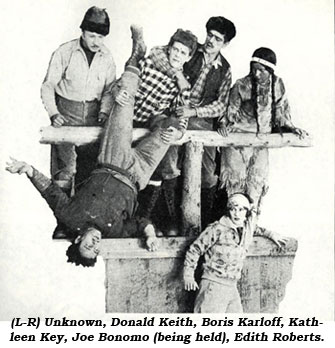 PHANTOMS OF THE NORTH (1929 Biltmore) 20 minutes PHANTOMS OF THE NORTH (1929 Biltmore) 20 minutes
William Henry Pratt left England at 22 to join a touring theatrical company in Canada. Taking the name Boris Karloff he eventually came to Hollywood in 1919. He is a halfbreed fur thief in the Harry Webb directed “Phantoms of the North” which starred Donald Keith as the fur trader Karloff has robbed. Edith Roberts, Joe Bonomo and Kathleen Key were also featured along with “two pals of the wild” Muro (Keith’s faithful dog) and wild horse Arab. Unfortunately, only the first 20 minutes of this feature seem to have survived and it ends just as the plot begins to thicken.
   RIDERS OF THE LAW (1922 Sunset) 51 minutes RIDERS OF THE LAW (1922 Sunset) 51 minutes
In Montana, near the Canadian border, Jack Hoxie and pal Frank Rice come across Sheriff Tom Lingham whom crooked deputy Pat Harman has shot and left for dead after Lingham discovered his illegal whiskey running business with saloon owner Frank Jonassen and outlaw Jack Pierce. Noticing one member of the gang rode a horse with half a shoe, Hoxie and Rice set up a blacksmith shop to find the killers. Good cinematography by Bert Longenecker (1876-1940) who photographed some 68 westerns from ‘22-‘39. Directed by prolific Robert North Bradbury. Cowboy Cancer alert—Jack lights up.
   PRAIRIE PIRATE (1925 PDC) 59 minutes PRAIRIE PIRATE (1925 PDC) 59 minutes
Mexican bandit Fred Kohler and his gang raid the home of Jean Dumas, but before the lascivious Kohler can “take her,” she kills herself. Returning home, Dumas’ brother Harry Carey discovers what has happened and, following a trail of broken cigarettes, he
 masquerades as the masked bandit The Yellow Seal to track down the bandidos. The trail leads to the hacienda of Spanish don Robert Edeson and his daughter Trilby Clark, for whom Carey instantly acquires an affection. Due to large gambling debts owed saloon owner Lloyd Whitlock (for whom Kohler now works), Edeson will lose his vast rancho unless he either pays off or allows his daughter to marry the lecherous Whitlock. Wounded while breaking up the unwanted marriage, Carey confesses to Clark his love for her just as Whitlock and Kohler break in. masquerades as the masked bandit The Yellow Seal to track down the bandidos. The trail leads to the hacienda of Spanish don Robert Edeson and his daughter Trilby Clark, for whom Carey instantly acquires an affection. Due to large gambling debts owed saloon owner Lloyd Whitlock (for whom Kohler now works), Edeson will lose his vast rancho unless he either pays off or allows his daughter to marry the lecherous Whitlock. Wounded while breaking up the unwanted marriage, Carey confesses to Clark his love for her just as Whitlock and Kohler break in.   Based on a W. C. Tuttle story, THE YELLOW SEAL, and produced by Hunt Stromberg (below). Stromberg, born in Louisville, KY, in 1894, was at first a newspaper reporter and sports writer for the ST. LOUIS TIMES but got into the Based on a W. C. Tuttle story, THE YELLOW SEAL, and produced by Hunt Stromberg (below). Stromberg, born in Louisville, KY, in 1894, was at first a newspaper reporter and sports writer for the ST. LOUIS TIMES but got into the
 motion picture industry prior to WWI, becoming publicity director for Goldwyn Pictures in NY. In 1918 the company sent Stromberg to California where he became the personal representative of Thomas Ince. By 1921 he had written, produced and directed his first film. He promptly resigned from Ince’s staff to form Hunt Stromberg Productions. In 1925 Stromberg joined newly formed MGM and became one of its key executives. He produced films starring Jean Harlow, Joan Crawford, Greta Garbo, Nelson Eddy and Jeanette MacDonald and the Thin Man series with William Powell and Myrna Loy. He left MGM in ‘42 after a rift with Louis B. Mayer. He died in 1968. motion picture industry prior to WWI, becoming publicity director for Goldwyn Pictures in NY. In 1918 the company sent Stromberg to California where he became the personal representative of Thomas Ince. By 1921 he had written, produced and directed his first film. He promptly resigned from Ince’s staff to form Hunt Stromberg Productions. In 1925 Stromberg joined newly formed MGM and became one of its key executives. He produced films starring Jean Harlow, Joan Crawford, Greta Garbo, Nelson Eddy and Jeanette MacDonald and the Thin Man series with William Powell and Myrna Loy. He left MGM in ‘42 after a rift with Louis B. Mayer. He died in 1968.
Posted 8/3/12
     EAGLE’S CLAW (1924 Aywon) 48 minutes EAGLE’S CLAW (1924 Aywon) 48 minutes
Big Boy Williams inherits half interest in the Eagle’s Claw gold mine with old timer Lafe McKee and his daughter (Kathleen Collins, to whom, at the time, Big Boy was married in real life). To steal the claim, conniving Lew Meehan and his gang try every trick in the claimjumping book…impersonation, raids, threats, even a vile, savage branding iron torture scene. But forget the hackneyed plot, it’s the constant barrage of thrill-a-minute action that lifts “Eagle’s Claw” far above the average B-western melodrama. Produced and directed by former Mack Sennett cameraman Charles Seeling (1895-1951) who was a very active writer/producer/director from 1918-1925—and nearly all of that was B-westerns with Big Boy whom Seeling had under personal contract. A more than competent director, for whatever reason, Seeling returned to cinematography in the ‘30s, working mainly for Warner Bros.
 BRONCHO BILLY’S FATAL JOKE (1914 Essanay) 18 minutes BRONCHO BILLY’S FATAL JOKE (1914 Essanay) 18 minutes
Broncho Billy plays a practical joke on old miner Carl Stockdale. Making Stockdale believe he’s struck it rich, it causes the old man to die of a heart attack. To repent, when Stockdale’s daughter (Marguerite Clayton) comes to see her father, Billy lets her believe his rich lode was Stockdale’s.
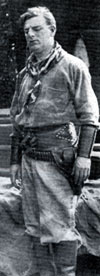  BRONCHO BILLY’S SENTENCE (1915 Essanay) 16 minutes BRONCHO BILLY’S SENTENCE (1915 Essanay) 16 minutes
Bandit Broncho Billy hides out in the home of minister Carl Stockdale who convinces him to repent and turn himself in to Sheriff True Boardman. Years later, Billy, now a prison preacher, is released.   Boardman was in dozens of westerns from 1911-1919. He died at only 38. His son became a respected screenwriter (“Bonanza”, “Gunsmoke”, “Virginian”). Boardman was in dozens of westerns from 1911-1919. He died at only 38. His son became a respected screenwriter (“Bonanza”, “Gunsmoke”, “Virginian”).
 SHOOTIN’ MAD (1919 Sherry Dist.) 27 minutes SHOOTIN’ MAD (1919 Sherry Dist.) 27 minutes
Leaving his Broncho Billy character behind in 1916, G. M. Anderson split with Essanay and in a comeback attempt, formed Golden West Productions in 1918 to produce features. However, better produced westerns were reaching movie houses. Billy’s competition had the advantage of superior plots and production values. His dated material was unable to stand up to his rivals. The Apollo Trading Col, headed by L. Lawrence Weber, financed the films and obtained all rights, re-editing the 10 features into two reelers and releasing them as “Oldtimer Tales”.  A slimy saloon owner has designs on the daughter of a just-come-west settler and lets the father and daughter squat on Bill’s ranch. When Bill returns he’s smitten by the girl but is suddenly framed for the killing of her father. A slimy saloon owner has designs on the daughter of a just-come-west settler and lets the father and daughter squat on Bill’s ranch. When Bill returns he’s smitten by the girl but is suddenly framed for the killing of her father.
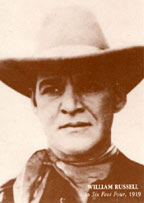     SIX FOOT FOUR (1919 Pathé) 59 minutes SIX FOOT FOUR (1919 Pathé) 59 minutes
Involved plot with lots of players but extremely well written, performed and excitingly directed by soon-to-be-noted director Henry King. 6'4" William Russell is at first suspected of a stage depot robbery and then, while trying to help Vola Vale take some money to her uncle (Charles K. French), is again accused of robbing her. Both times he is being framed by the actual culprits crooked sheriff Clarence Burton, his deputies Ben Broderick and Jack Collins, gunman/gambler Jack Brammall, and even Vale’s duplicitious Uncle. With the aid of secretive U.S. Marshal Harvey Clark and a lost spur rowel, Russell eventually clears his name and brings the gang to justice.   Versatile William Russell was equally adept at romance, comedy, melodrama or westerns, but he’s best remembered for the latter in a screen career that reached from 1909 to 1929. The New York born Russell was asked to fill in for an ailing actor in a play at a theatre where he was an usher. He liked the way of life and broke into films circa 1909. Unlike Mix, Jones or Hart, Russell never specialized in westerns, not making his first til 1917. Allying himself with director Henry King and writer Stephen Fox in Versatile William Russell was equally adept at romance, comedy, melodrama or westerns, but he’s best remembered for the latter in a screen career that reached from 1909 to 1929. The New York born Russell was asked to fill in for an ailing actor in a play at a theatre where he was an usher. He liked the way of life and broke into films circa 1909. Unlike Mix, Jones or Hart, Russell never specialized in westerns, not making his first til 1917. Allying himself with director Henry King and writer Stephen Fox in
 1918, they turned out some hard ridin’ hits. Even better production values enhanced the Fox westerns he starred in next (‘19-‘23). His final films were made freelance (some under his own production setup) where, by now, he was accepting character roles. He never had the chance, like William Farnum or Jack Holt, to move into talkies as he died at only 45 of pneumonia in 1929, making it difficult to evaluate his true potential. In his time he was a star that a 1919 review said “always delighted crowded houses…always the rule when Russell appears in one of his breezy, snappy pictures.” 1918, they turned out some hard ridin’ hits. Even better production values enhanced the Fox westerns he starred in next (‘19-‘23). His final films were made freelance (some under his own production setup) where, by now, he was accepting character roles. He never had the chance, like William Farnum or Jack Holt, to move into talkies as he died at only 45 of pneumonia in 1929, making it difficult to evaluate his true potential. In his time he was a star that a 1919 review said “always delighted crowded houses…always the rule when Russell appears in one of his breezy, snappy pictures.”   Director Henry King (1886-1982) began as an actor in 1913 with over 100 credits. By 1915 he was directing a variety of films, including silent westerns with Russell. Having cut his teeth in silents he easily moved into talkies becoming one of the most commercially successful directors of the ‘20s, ‘30s and ‘40s helming such smashes as “Ramona”, “Song of Bernadette”, “Wilson”, “Stanley and Livingstone”, “Jesse James”, “The Gunfighter”, “Beloved Infidel”, “The Bravados”, and scores of others. Director Henry King (1886-1982) began as an actor in 1913 with over 100 credits. By 1915 he was directing a variety of films, including silent westerns with Russell. Having cut his teeth in silents he easily moved into talkies becoming one of the most commercially successful directors of the ‘20s, ‘30s and ‘40s helming such smashes as “Ramona”, “Song of Bernadette”, “Wilson”, “Stanley and Livingstone”, “Jesse James”, “The Gunfighter”, “Beloved Infidel”, “The Bravados”, and scores of others.
   ROARING RAILS (1924 Producers Dist. Co.) 67 minutes ROARING RAILS (1924 Producers Dist. Co.) 67 minutes
At the end of WWI Harry Carey is a disbarred railroad engineer who has adopted a war orphan, Frankie Darro. The pair winds up on the bum in the Northwest where Carey obtains a laborer job on the Overland Union railroad which is rapidly being constructed to meet an August deadline. Crooked Wallace MacDonald and roughneck Overland foreman Frank Hagney are bent on sabotaging the line so they can take over for the Central Pacific. Young Darro, blinded when Hagney blows up a train trestle, is in desperate need of a costly eye operation, so when MacDonald’s treachery is discovered by the Overland Owner and MacDonald murders him, Carey tells MacDonald he’ll take the blame for the killing if MacDonald will pay for Darro’s eye operation and care for the boy. Carey is imprisoned but MacDonald has no intention of keeping his word and sloughs Darro off to the abusive Hagney. Learning of this from lady friend Edith Roberts, Carey escapes prison. Chased by the Sheriff, Carey and Roberts rush into the train station where, during a forest fire set by Hagney, Overland officials are offering $10,000 to anyone who can get their locomotive through and complete the line’s final destination on schedule. The spectacular ending in which Carey is vindicated and Darro’s sight is restored is a stunner. Not a “true” western, but contains many elements of the genre.
Posted 12/6/11
    SKY HIGH (1922 Fox) 61 minutes SKY HIGH (1922 Fox) 61 minutes
Utilizing the Grand Canyon—and even the historic El Tovar Hotel (opened in 1905—still in operation)—as a backdrop, this is one of Tom Mix’s greatest, action-filled westerns. Tom is a deputy border immigration patrolman whose duty it is to capture the smugglers of Chinese Coolies and prevent the Orientals from crossing the border illegally. Meanwhile, college graduate Eva Novak comes west to visit her guardian uncle (J. Farrell MacDonald) who is secretly the head of the smugglers. While infiltrating the gang at their camp in the Grand Canyon, Tom comes upon and rescues Novak who has become lost in the Canyon. Soon discovered and captured by the outlaw band, headed up by Sid Jordan, Tom breaks free and rides for help, enlisting the aid of a Forest Patrol aviator and his plane in nearby Williams, AZ. (There’s a historic shot of Williams as it was in 1922 at this point.) Flying over the canyon in spectacular aerial footage with the pilot (real life aviator Bud Creeth), Mix lowers a ladder rope and drops into the swirling Colorado River. The action of Mix scaling high canyon walls, riding hell-bent-for-leather on treacherous, winding paths, swimming the dangerous Colorado River, rescuing Novak and capturing the smugglers is one big thrill-packed feast from beginning to end. If SKY HIGH doesn’t keep you on the edge of your seat, nothing will.

Posted 9/2/11
   3 BAD MEN (1926 Fox) 122 minutes 3 BAD MEN (1926 Fox) 122 minutes
Striving for another epic success like “The Iron Horse” director John Ford latched onto “3 Bad Men”, the plot of which follows three outlaws who redeem themselves while protecting pilgrims on their way to the 1877 Dakota landrush. Spectacular location shooting near the Grand Tetons at Jackson Hole, WY, affords a sweeping panoramic background for the scenes of outlaws and the wagon train journeying through the badlands of Dakota, but the script and Ford’s direction—filled with far too much incidental romance, Irish humor and extraneous subplots—makes “Three Bad Men” fall short of another out-and-out classic. Apparently, Ford envisioned Tom Mix, Buck Jones and George O’Brien as the three bad men of the title, but Fox executives believed Mix and Jones too valuable to waste on a single picture so Tom Santschi, J. Farrell MacDonald and Frank Campeau
 were given the leads and O’Brien was shuffled off to nothing much more than the juvenile lead—although he retained star billing. Lou Tellegen, who had been working as a star at Fox for several years, but was beginning to age into character parts, was given the role of the corrupt Sheriff who “ran the mushrooming town with a high hand, keeping his own lawless gang in check.” * * The film opens as Santschi and his partners (MacDonald, Campeau) head for the gold fields of the Dakotas looking for his lost sister, but along the way wind up going to “work” protecting Olive Borden, who has lost her father. O’Brien, an expelled West Point cadet, joins the settlers on the way to the Dakotas, immediately falling in love with Borden. The overly-long film’s climax is an unequalled landrush sequence of were given the leads and O’Brien was shuffled off to nothing much more than the juvenile lead—although he retained star billing. Lou Tellegen, who had been working as a star at Fox for several years, but was beginning to age into character parts, was given the role of the corrupt Sheriff who “ran the mushrooming town with a high hand, keeping his own lawless gang in check.” * * The film opens as Santschi and his partners (MacDonald, Campeau) head for the gold fields of the Dakotas looking for his lost sister, but along the way wind up going to “work” protecting Olive Borden, who has lost her father. O’Brien, an expelled West Point cadet, joins the settlers on the way to the Dakotas, immediately falling in love with Borden. The overly-long film’s climax is an unequalled landrush sequence of
 action as horses, wagons, bicycles and settlers on foot race to stake their claims. (Ford’s footage is frequently seen as stock in later westerns.) The night before the landrush Sheriff Tellegen burns the settlers’ church, killing many people, as he and his gang sneak across the deadline to get the jump on the pending land opening. * * Although O’Brien gets star billing it’s Tom Santschi’s film all the way, repenting his evil ways when his long lost sister, Priscilla Bonner, is rebuffed by Tellegen and left to die in the church fire. * * 6' 1" Santschi, born in 1876 in Switzerland, was brought to the U.S. at a young age and raised in Kokomo, IN. One of the earliest silent stars, he began his career in 1906—acting, directing and producing with the Selig Company as of 1907. After 11 years with Selig, he joined Universal and other companies. He’s best remembered for his co-starring role in 1914 with William Farnum in “The Spoilers”, the film that set the tone for fights in subsequent films. At 54 when sound arrived in 1929, Santschi’s star had faded. He worked in several low budget westerns and serials before his death on April 19, 1931. action as horses, wagons, bicycles and settlers on foot race to stake their claims. (Ford’s footage is frequently seen as stock in later westerns.) The night before the landrush Sheriff Tellegen burns the settlers’ church, killing many people, as he and his gang sneak across the deadline to get the jump on the pending land opening. * * Although O’Brien gets star billing it’s Tom Santschi’s film all the way, repenting his evil ways when his long lost sister, Priscilla Bonner, is rebuffed by Tellegen and left to die in the church fire. * * 6' 1" Santschi, born in 1876 in Switzerland, was brought to the U.S. at a young age and raised in Kokomo, IN. One of the earliest silent stars, he began his career in 1906—acting, directing and producing with the Selig Company as of 1907. After 11 years with Selig, he joined Universal and other companies. He’s best remembered for his co-starring role in 1914 with William Farnum in “The Spoilers”, the film that set the tone for fights in subsequent films. At 54 when sound arrived in 1929, Santschi’s star had faded. He worked in several low budget westerns and serials before his death on April 19, 1931.
     LIGHTNING BRYCE (1919 Arrow 15 chapter serial) LIGHTNING BRYCE (1919 Arrow 15 chapter serial)
Silent serial queen Ann Little’s miner father discovers a rich gold deposit sacred to the La Conche Indians. After secreting the whereabouts of the mine on a string wrapped tightly around a Bowie knife he is drugged with Peyote smoke by Indians and made to believe he killed his partner, Jack Hoxie’s father. Before Ann’s father dies, she is given the string and Jack is given the Bowie knife. The mine can only be located by winding the string over the blade in the proper manner, hence revealing directions to the gold. Learning of the gold, crooked deputy Paul Hurst and his gang try every means to steal the “map” from Ann and Jack. As well, the La Conche tribe sends a threatening emissary (Steve Clemente) to recover the string and knife to protect their hallowed treasure. Constantly in peril from both Hurst’s hazardous plots and the cunning Indian, Jack and Ann are often protected by a strange white garbed mystery woman (Jill Woodward) whose motives remain a riddle until the end. * * Although Jack Hoxie had worked in films since 1910, billed as Hart Hoxie, “Lightning Bryce” was his breakthrough, establishing him as a western hero. Directed by Paul Hurst, the serial is filled with perilous feats (including a battle with a trained wolf whose fangs actually penetrated Jack’s leg) and thrilling action both on the western desert and in the cities of San Francisco and New York. Arrow immediately put Jack into another serial, “Thunderbolt Jack” (1920), followed by a series of feature westerns through 1922 when Jack went with Anthony J. Xydias’ Sunset Productions for eight before moving up to prestigious Universal in ‘23 where he became a major silent western star, ranking alongside Tom Mix, Fred Thomson and others. Hoxie remained with Universal until 1927 when he and studio head Carl Laemmle differed over a new contract and Jack walked out. Whether or not Hoxie realized his mistake, it was too late. His only other silent work was a ‘27 serial for Mascot, “Heroes of the Wild”. He didn’t return to the screen until 1932 in a low budget series of six talkies for Majestic.
    JUST PALS (1920 Fox) 49 minutes JUST PALS (1920 Fox) 49 minutes
After playing character roles in Franklyn Farnum’s Canyon Pictures two-reelers and features at Fox with Tom Mix, Buck Jones was elevated to star status by studio head William Fox in the event Mix decided to bolt. Buck’s first starrer was “The Last Straw” in February ‘20 followed by “Firebrand Trevison” and “Just Pals”, which was director John Ford’s first of two with the fledgling star. Pathos, comedy and action are all interwoven in the complicated plot,
proof that Jones truly was one of the best western actors. * * Town loafter Buck Jones, in

love at a distance with schoolmarm Helen Ferguson, rescues runaway orphan boy George Stone from a mean railroad brakeman. Both with their belts drawn tight, kindred spirits become pals. Ferguson, engaged to local express company cashier William Buckley, entrusts Buckley with the local school board money when Buckley tells her he needs a loan for a brief while as he is “short on his accounts,” when in truth he is an embezzler. When the school board comes looking for the money, Ferguson, in shame and despair, tries to drown herself. Learning of her plight, and not wanting her misjudged, Buck forces Buckley to give him the money, gives it to the board, and takes the blame for its disappearance. Driven out of town by the self-righteous townfolk, he and Stone wind up in a hobo camp where a gang of thieves are plotting with Buckley to rob the express office. Although Buck thwarts the robbery, he is again, because of his bad name, about to be lynched as a robber when Stone explains to the mob what really happened. A subplot involving a kidnapped child (at once believed to be Stone) nets Buck a $10,000 reward, allowing Buck, Helen and George to live happily ever after.

   WHERE THE NORTH BEGINS (1923 WB) 69 minutes WHERE THE NORTH BEGINS (1923 WB) 69 minutes
Rin Tin Tin’s first feature has Rinty falling out of a moving crate being shipped across the Canadian wilderness. Raised by wolves, his first contact with a human is when his natural dog instincts kick in as he rescues French-Canadian Fred Huntley from a deadly ambush by an assassin known as The Fox (Charles Stevens). Seems a devious outpost factor, Walter McGrail, has sent Huntley to Skagway with a valuable load of furs then instructed Stevens to waylay him. Left for dead by Stevens, Huntley is nursed back to health by Rin Tin Tin, but Huntley is framed by McGrail for the theft of the pelts when he returns to the outpost. Through a piece of fabric ripped from Stevens clothing, Rinty exposes the real culprits.
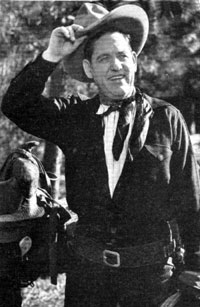   RANCHERS AND RASCALS (1925 Steiner) 42 minutes RANCHERS AND RASCALS (1925 Steiner) 42 minutes
After a series of successful two reelers, labeled The Range Rider series, Leo Maloney branched out into feature westerns through a distribution contract with William Steiner Productions, all directed by Maloney himself. Maloney retained the same basic cast in all 13 films—leading lady Josephine Hill, badmen Leonard Clapham (Tom London), Bud Osborne and Jim Corey, character players Horace Carpenter, Indian actor Whitehorse and Barney Furey along with Maloney’s dog Bullet. Each film had strong undercurrents of humor and good plots which often had novelty elements taking the place of explosive action. “Ranchers and Rascals” is a perfect example. If ever there was a sitcom western, this is it; still with enough bravado to
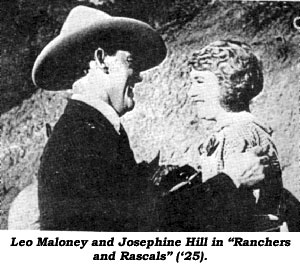 satisfy western purists. * * On Leo’s wedding day to Josephine Hill, the once spurned Tom London (and his cohort Bud Osborne) happen across Patricia Darling and her baby on the run from city dude Barney Furey over custody of the child. Seeing his chance to frame Leo, London plots to disrupt the wedding by hiding out Darling and the baby in Leo’s house. Needless to say, when Josephine, her mother and father (Whitehorse) and the wedding party arrive the story turns into a comedic mix-up not unlike a Leon Erroll comedy short. satisfy western purists. * * On Leo’s wedding day to Josephine Hill, the once spurned Tom London (and his cohort Bud Osborne) happen across Patricia Darling and her baby on the run from city dude Barney Furey over custody of the child. Seeing his chance to frame Leo, London plots to disrupt the wedding by hiding out Darling and the baby in Leo’s house. Needless to say, when Josephine, her mother and father (Whitehorse) and the wedding party arrive the story turns into a comedic mix-up not unlike a Leon Erroll comedy short.
  ARIZONA KID (AKA “Pursued”) (1929 Davis) 40 minutes ARIZONA KID (AKA “Pursued”) (1929 Davis) 40 minutes
Art Acord was still popular but had certainly fallen from grace since his glory years at Universal (1920-1927) due to his drinking. J. Charles Davis had been producing westerns with Bob Custer and latched on to the remaining screen virtues of Acord’s name for a series of eight low budgeters—possibly only six of which were ever made (or released). “The Arizona Kid” (videotape copies erroneously titled “Pursued”) was the third release. Art is a U. S. Marshal broadly disguised as an outlandishly attired effeminate fop who infiltrates renegade Cliff Lyon’s outlaw gang, thinking him good for a laugh. Art obviously has quite a
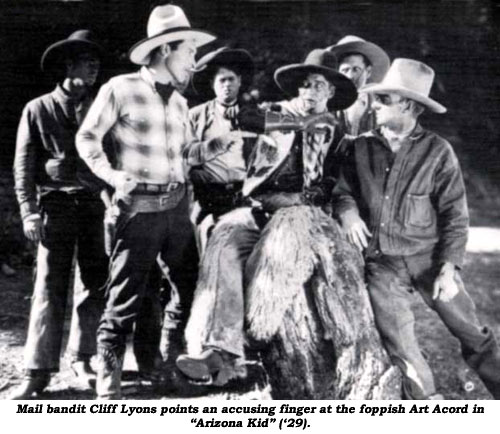
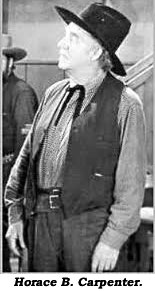
time with his “queer duck” routine as he plans to rescue mail wagon driver Horace Carpenter who has been robbed and taken prisoner by Lyon’s gang—who also soon grab Carpenter’s daughter Carol Lane as well. * * Assistant director James Tromp and assistant cameraman George Hollister play minor roles. Art’s horse is Star and his dog is Rex, although nothing special is done with them. Director/actor Horace B. Carpenter, born in Sauk Rapids, Benton, MN, in 1875, broke into movies with Famous Players–Lasky at 39 in 1914 after playing a variety of roles on the stage; which he also did on screen from ‘14-‘18. He seems absent from the screen then until returning in ‘23 where, from then on, he was closely associated with westerns, acting in some 400 mostly uncredited parts through 1945 when he died at 70 on May 21. He directed 13 low budget silent westerns (and a couple of non-westerns) from 1924-1929 starring Lester Cuneo, Bill Patton, Art Acord and Art Mix.
    THE SHOW DOWN (1921 Universal) 18 minutes THE SHOW DOWN (1921 Universal) 18 minutes
Universal’s “Moon Riders” 18 chapter serial in 1920 put Art Acord into the upper ranks of western stardom. “The White Horseman” serial in ‘21 strengthened Acord’s standing even more. In between serials, Art turned out continuous action packed two reelers like “The Show Down” in which Marcella Pershing’s guardian, Ed Burns, has embezzled the lass’ inheritance. Art Acord becomes aware of her situation and rides to her rescue. One truly exciting “cliffhanger” of a sequence will absolutely make you jump. * * Leading lady Marcella Pershing was a second cousin of famed WWI General John J. “Black Jack” Pershing.

   SAND (1920 Paramount-Artcraft) 49 minutes SAND (1920 Paramount-Artcraft) 49 minutes
The first William S. Hart western produced by his own company, after freeing himself from the production reins of Thomas H. Ince…and it’s a good one. “I want my next two years in pictures to be free from worry about business,” Hart stated, “so I can devote my time to making good photo-dramas.” Directed, as other Hart westerns had been, by Lambert Hillyer, “Sand” was basically a railroad story filmed in late 1919 on the desert outside Victorville, CA. Hart’s favorite horse, the pinto Fritz, had been out of Bill’s films for a couple of years and “Sand” was his return, with advertisements making the most of the pinto’s return. Fritz, named Boss in the picture, is expertly incorporated into the storyline. * * “Sand” opens with Hart on his way to replace elderly Hugh Jackson as railroad station agent in the town of Condor. On the way, Hart is made aware of bandits who recently robbed the train of $20,000 and got clean away. Arriving in Condor, Hart finds the man he is to replace is the father of a girl he fell in love with sometime back, Mary Thurman. At first he declines the job, but Mary explains she and her Pop are going to work in the general store of G. Raymond Nye who is also the primary stockholder in the railroad as well as having his eyes set on Mary. The duplicitous Nye eventually manages to have Hart fired, but Bill immediately gets a job on a nearby ranch with old pal Bill Patton. At the same time Hart learns he is getting his old pinto horse, Boss (Fritz), back again. Mary overhears a conversation between Hart and Patton and believes Bill is in love with another woman. Hurt, she at first agrees to marry Nye. Hart, crushed, fades away to work on the ranch and tries to track down the elusive train bandits. Realizing she doesn’t love Nye, Mary decides to leave Condor on the train. In the desert, Hart comes upon the train bandits—led by Nye—attempting to hold up the very train carrying Mary.
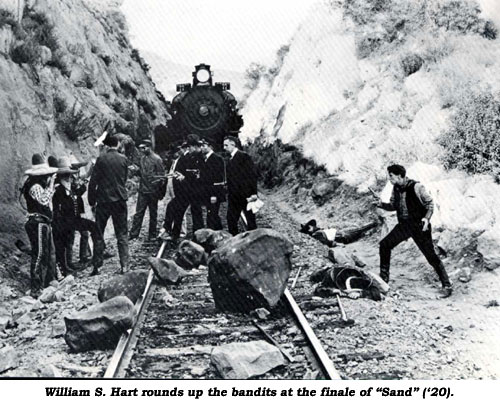
Posted 5/21/11
 DESERT RIDER (1923 Sunset) 52½ minutes DESERT RIDER (1923 Sunset) 52½ minutes
Jack Hoxie’s final western for poverty row producer Anthony J. Xydias before joining more prestigious Universal is a slow affair as Jack and his sidekick Frank Rice find little Walter Wilkenson stranded in the desert after thief Claude Payton has shot Walter’s father (Tom Lingham) in an attempt to steal his gold mine map. Before Lingham dies Jack promises to care for the orphaned boy and work Lingham’s mine. They are soon joined by Evelyn Nelson, an eastern girl come west who had lost her way in the desert. Trickster Payton tries to blame his own murderous deeds on Jack, but his scheme backfires in a surprise windup—unfortunately, it all comes too late after 45 minutes of routine drearydom. A couple of drawn-out “comic” scenes with Frank Rice and Wilkinson are nothing but padding and do nothing to help the film’s already slow pacing. Director Robert North Bradbury had just graduated to feature work after heading up a slew of Tom Santschi and Art Acord shorts. He did much better work later on with his son Bob Steele and John Wayne.
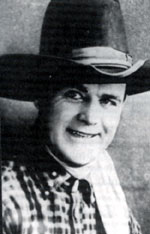     BETTER MAN WINS (1922 Sanford) 63 minutes BETTER MAN WINS (1922 Sanford) 63 minutes
Excitement from the get-go as Pete Morrison protects Dorothy Woods from rustlers. The couple is soon engaged but trouble enters their love affair when eastern society dame Gene Crosby and her neer-do-well manager Jack Walters literally crash-land on Dorothy’s doorstep. While Crosby stays at Dorothy’s ranch for six weeks recuperating from a broken leg, she sets her cap for Morrison. Meanwhile, Walters tries to force his attentions on Dorothy. Torn between infatuation and love, Pete chooses to go east with Crosby. More tragedy befalls Dorothy when her invalid father dies and she’s forced to auction off her ranch. Now discarded by Crosby, the wily Walters preys upon Dorothy’s downfall in life, putting her to work in his cabaret. Tainted by the wicked ways of eastern society, Pete eventually sees Crosby’s true colors and realizes the terrible mistake he has made in deserting Dorothy. Returning west, he finds Dorothy in the cabaret-clutches of Walters and sets out to right his wrong. Melodramatic at times, but a fine little film that extols the virtues of the West while condemning the lurid and wicked ways of Eastern society. Scripted and directed by Marcel Perez (1885-1927) who began his acting/writing/directing career in his native Spain. From 1910 to 1923 Perez played Tweedledum, Twede-Dan or Tweedy in a long series of comedy shorts. Oddly, this feature and “Pioneers of the West” with Dick Carter seem to be his only feature directorial work. (He also acted in “Lash of the Law” in ‘26.) His death at only 42 cut short what could have been a promising career in sound films.
  ROMANCE OF THE WASTELAND (1924 Aywon) 45 minutes ROMANCE OF THE WASTELAND (1924 Aywon) 45 minutes
While stopped in a small town, a young child, traveling west with her mother (Alma Rayford) gets off the train to pet a dog and is left behind when the train pulls out. Art Mix spots the stranded young waif and takes her to his ranch. Meanwhile, Rayford discovers her daughter missing and hires a car to search for the lost child. Finding the girl safe with Art, he and the sheriff obtain a job for Rayford “slingin’ hash”. Trouble arises when two hobos arrive in town, one of whom, Joe, is the no good husband of Rayford she came west to escape. Pretty dramatic finish.
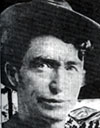  THE TRYOUT (1919 Capital/Nu-Art) 24 minutes THE TRYOUT (1919 Capital/Nu-Art) 24 minutes
Fresh, young Tom Ashton wants to ride the owlhoot trail with Al Jennings (billed as America’s reformed outlaw), so Al agrees to give him a three day tryout. To dissuade the young wannabe, good-badman Jennings has Ashton encounter a child abuser, a double-crosser and a treacherous killing, convincing Ashton the life of an outlaw is not for him. Very low rent production values.
 TRAIL OF THE AXE (1922 American Releasing) 49 minutes TRAIL OF THE AXE (1922 American Releasing) 49 minutes
To meet his contract demands, Dustin Farnum must put his lumber mill workers on double shift. Also, to save his brother George Fisher from an alcoholic state, Farnum gives him a job, only to learn the girl he loves, Winifred Kingston, plays to marry his brother, even against her father’s will. As George continues to drink on the job, even Kingston begins to lose faith in him. True to his drunkardness, George blames the loss of his girl and even his own alcoholism on brother Farnum and vows to get even by setting off an explosion at the mill, then excites rebellious loggers to burn the camp. Overly melodramatic. ^ ^ Dustin Farnum was born in Hampton Beach, NH, May 27, 1874, the oldest of four children born to the professional acting team of George and Adele Farnum. Brother Marshall died at 17 and sister Clara at 7. William and Dustin went on to stage and film fame. Dustin made his movie debut in 1913 and got his big break in Cecil B. DeMille’s “The Squaw Man” in 1914, As his acting never quite lost its stage training, he retired from films in 1926. He was 55 when he died on July 3, 1959. Married three times, his third wife was Winifred Kingston, his English born co-star in this film and some 17 others. She left films in 1928 and dropped from the public eye.
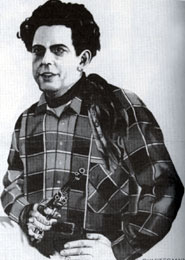   TWO FISTED JUSTICE (1924 Arrow) 50 minutes TWO FISTED JUSTICE (1924 Arrow) 50 minutes
Seeking tinhorn gambler and murderer Morris Foster, Sheriff Dick Hatton poses as an outlaw and infiltrates Arthur Morrison’s gang, not realizing the man he seeks is part of that very gang. Also there is Foster’s abused and distraught wife, Marilyn Mills. Discovering Foster, Hatton helps Mills flee the outlaw camp. His true lawman identity revealed, Hatton is bound by Morrison’s gang, but in true B-western fashion, Dick is rescued by his horse, Star. Badmen fallout as Morrison and Foster clash while Hatton rides to Mill’s defense. In many ways Hatton’s looks and acting style remind one of William Farnum. This one, produced by Ben Wilson, is also directed by Hatton in an often erratic, confused and stagnant manner.
top of page
|



